Rolex watches are a product of the combination of movements, cases, bezels, bracelets, and dials. Of all these parts of a Rolex timepiece, the metal options are undoubtedly worthy of note. In this post, we look into the various types of metals Rolex utilizes to create their timepieces. Some of these Rolex metal options helped in the creation of Rolex watches historically, while others still help presently.
Meanwhile, a gold Rolex timepiece is presently a globally celebrated symbol of fame and personal feats. Nevertheless, Rolex produces its wristwatches using a number of distinct materials. With these different metal options, Rolex easily achieves a range of looks and varying levels of luxury.
What a yellow gold Rolex timepiece presents is a tried and true aesthetic piece. On the other hand, the following are some of the other numerous options that Rolex offers presently and in vintage pieces.
Types of Rolex Metal Options
- Stainless Steel (Oystersteel)
- White Gold
- Everose Gold
- Platinum
- Yellow Rolesor
- White Rolesor
- Everose Rolesor
- Rolesium
- Matching Metals
- Sterling Silver (Vintage Rolex)
-
Introducing the Stainless Steel (Oystersteel) Metal
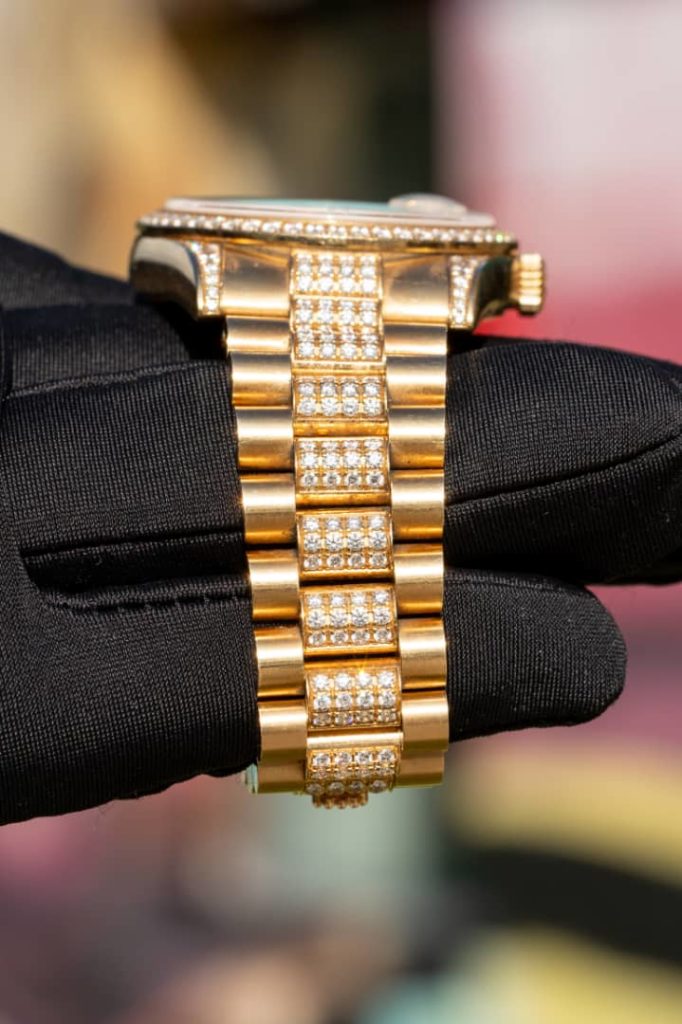
Indeed, this metal option is the most popular and simple material from Rolex. The Swiss watchmaker uses this metal to produce its watches. Also, the stainless steel material remains the most practical of all the metal options from Rolex. To add to this timepiece being considerably less costly than gold, stainless steel is again quite lighter and stronger. These qualities make for an overall more powerful, lasting, and reliable timepiece.
Right from Rolex’s in-house foundry located at their Plan-les-Ouates station, this watchmaker produces its own 904L stainless steel alloy. This alloy is also known as Oystersteel. Being highly corrosion resistant and able to take on a rare sheen when polished, the Oystersteel is a favorite choice.
Thanks to its anti-corrosion qualities, 904L stainless steel is a frequent presence in high-technology and the chemical and aerospace industries. This material is highly practical from a functional perspective. More so, the unique properties of 904L stainless steel enable Rolex wristwatches to retain their beauty and finish. It does this even in non-conducive settings.
Do you want an everyday watch, a sports watch, or even a dress watch? The stainless steel remains the best option for a grand Rolex watch. This Rolex material is the most universal metal utilized at Rolex. Moreover, aside from the Day-Date and the Pearlmaster lines, it is accessible as an alternative across all models. Additionally, legendary Rolex tool watches like the Submariner, GMT-Master, and Daytona started with stainless steel models. Letter on, Rolex proceeded to offer more luxurious gold choices.
-
History of the Stainless Steel Rolex Metal Option
A larger part of the company’s history reflects how Rolex depended on industry-standard 316L stainless steel to draw up their wristwatches. For example, 316L stainless steel gets valued for its anti-corrosion properties and durability. Also, this material often gets referred to as “marine grade steel.”
Note: The “L” in 316L denotes a low carbon version of 316 steel. That is an improved option for high temptations and welding.
Following countless scenes as displayed in times past, Rolex maintains a firm focus on enhancing details. It doesn’t matter if they are big or small. This explains why in 1985, the company came to be the first watchmaking brand to employ a 904L stainless steel for its cases. First, it was the Sea-Dweller, and Rolex finally turned its all steel Rolex models to 904L steel cases.
Meanwhile, it is important to point out that Rolex utilized 904L stainless steel in their cases. At the same time, the brand continued using 316L stainless steel for its bracelets. But, that changed in the 2000s, when Rolex started to use 904L stainless steel for both bracelets and cases solely.
-
The Difference Between 904l Stainless Steel and 316l Stainless Steel
Rolex describes the 904L stainless steel as a “superalloy” This is as the material delivers even better resistance to corrosion. More so, this is a more durable metal option compared to 316L stainless steel. In addition, it also gives a rare radiance after polishing.
Then, in 2018, Rolex started referring to the 904L stainless steel they use as Oystersteel. This watchmaking company notes that they created the formula of their distinct steel alloy.
Note that Rolex does not make 904L stainless steel in-house. However, Rolex depends on special suppliers to provide it. Still, in real Rolex fashion, the quality-obsessed watchmaker inspects every Oystersteel casting in their central lab. With a scanning electron microscope, the brand checks tho material prior to the material making it to the watch production phase.
-
Introducing the Rolex Gold Material
After steel, gold is the next most prominent metal utilized by Rolex in the production of its watches. Well, it doesn’t come in just one shade. In fact, this material comes in three shades.
- The yellow gold,
- The white gold, and
- The rose gold.
Unlike what most Rolex lovers believe, not all gold Rolex watches are 18k gold. In fact, you will find vintage Rolex watches created using 9k and 14k gold. Also, there are gold shell vintage Rolex timepieces out there. These versions are products of a technique of bonding a thick layer of yellow gold to steel.
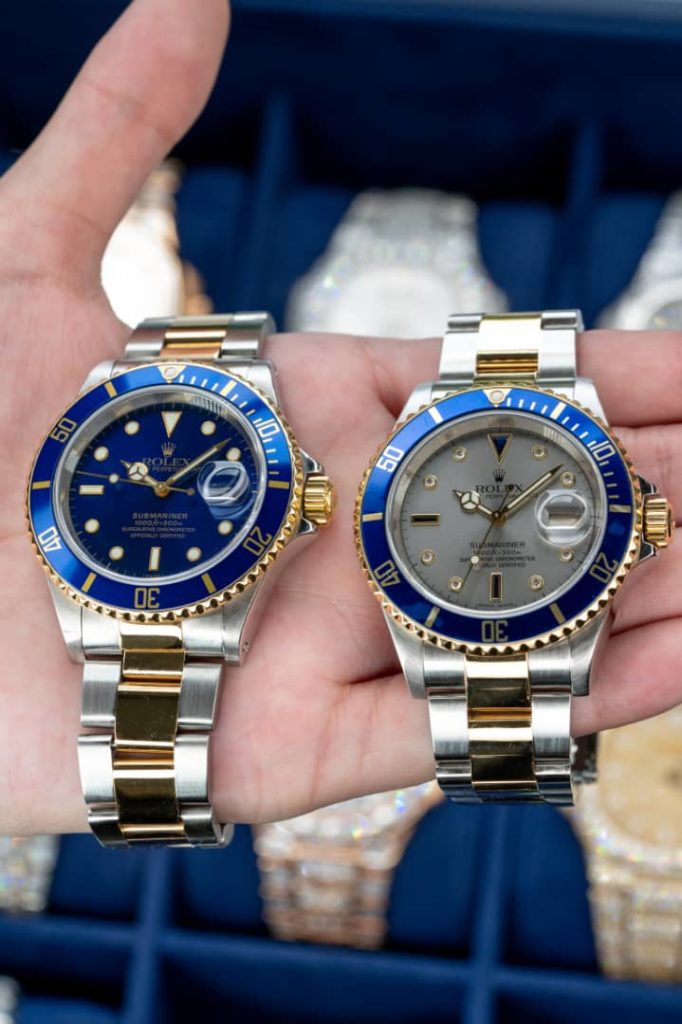
However, presently, Rolex only utilizes 18k gold to make its wristwatches. The brand has four distinct sites around Switzerland. Particularly, the one in Plans-les-Ouates (built-in 2006) houses Rolex’s private foundry. If you didn’t know, Rolex produces its own exclusive gold alloys in its own in-house foundry.
According to Rolex, Pure gold is 24k and it is too flexible to utilize in the production of robust wristwatches. Therefore, Rolex goes for 18k gold, which is 75% gold and 25% other metals for better results. Also, there is the addition of certain amounts of other metals, such as silver, copper, platinum, and others. These additions are what produce the various gold colors we are familiar with. Hence, Rolex can regulate the precise formulas of their gold alloys in their sheltered foundry.
Truly, Rolex uses rose gold in their watches and this has been for decades. Yet, in 2005, the brand introduced a patented rose gold alloy they call Everose. For this special gold, it derives its name from Rolex’s pledge that this proprietary pink gold will never fade. Rolex promised that it will remain (for) everose.
Below are the types of Rolex Gold materials explained:
-
The White Gold Rolex Material
Some Rolex lovers prefer the ultra-premium touch of a solid gold Rolex. Still, they do not necessarily like to wear a completely yellow gold watch as their everyday watch. When this is the case, 18-karat white gold is a terrific option. It contains all the same qualities of traditional yellow gold in a more adaptable and understated assortment.
Just like almost everything else that Rolex creates, the white gold utilized for Rolex watches is a proprietary 18-karat alloy. Here is an alloy that comes particularly engineered for outstanding durability. Additionally, it takes on a stunning luster when polished. Besides, Rolex reserves particular configurations of timepieces for white gold references only. Examples include the all-blue “Smurf” Submariner and the Yacht-Master 42.
-
Everose Gold Rolex Material
The Everose Rolex material is a modern metal finish, officially released to the market in 2005. This Rolex metal option is practically a rose gold (or pink gold) alloy drawn up from a mixture of pure gold, copper, and platinum.
Indeed the rose gold remains one option within the Rolex catalog from the past. Still, Everose is the first time the metal finish gets produced completely in-house. We must mention again that it is a product of the Rolex foundry. Meanwhile, the brand crowned it “Everose” instead of just publicizing it as rose gold. Additionally, it comes specifically engineered not to forfeit its warm shade with exposure to the elements.
More so, Everose gold is on-trend with recent watch preferences. Also, it is an alternative for many of the models in the Rolex catalog. This Rolex material is sought-after by both men and women for its timeless, warm hues. Moreover, Everose is a stunning alternative to yellow gold. This metal option offers the luxury of an all-gold watch with a narrowly more contemporary aesthetic.
-
Yellow Rolesor Rolex Metal Option
One of the most prominent metal options for Rolex timepieces is the mixture of stainless steel and gold. This metal option in Rolex nomenclature bears the name Rolesor. As for Yellow Rolesor watches, they follow a related aesthetic to the classic gold Rolex.
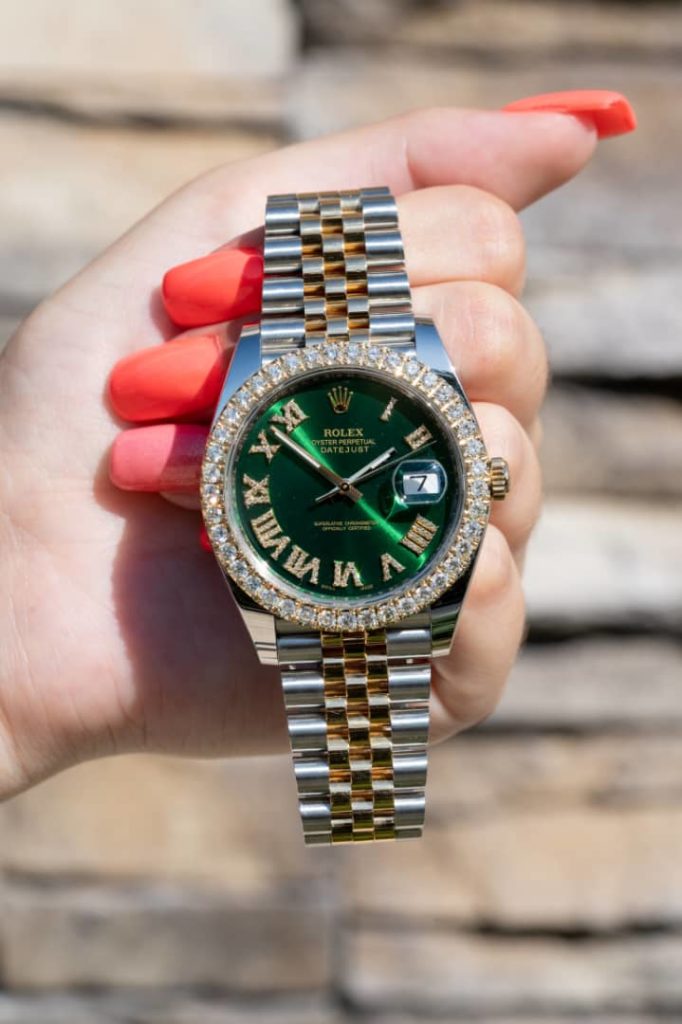
Nevertheless, the addition of stainless steel elements makes for a narrowly more adaptable and subdued impression. More so, two-tone watches get more effortlessly fitted to supporting pieces of jewelry or other items within a person’s closet. Besides, two-tone Rolex watches come considerably less costly compared to their solid gold equivalents. This is despite embodying similar movements and containing a very identical visual image.
-
White Rolesor Rolex Material
Here is a truly outstanding luxury Rolex material. It is strong, reliable and easy to wear. The White Rolesor delivers in every regard. The versatile white metal finish in stainless steel and white gold is perfect for practically any event. Here is a material that stays durable without compromising on luxury or style. Similar to the Yellow Rolesor, this Rolex metal option guarantees a more accessible price range compared to an all-gold timepiece.
It’s easy to tell a White Rolesor timepiece apart from an all-steel one as it will always come with a fluted bezel in white gold. As for steel watches, they typically only come with smooth bezels. More so, note that Yellow Rolesor and Everose Rolesor models come with their bezels, winding crowns, and center bracelet links drawn up from gold. As for the White Rolesor Rolex wristwatches, they are primarily products of stainless steel. You find the 18k white gold metal option only used for the bezel, hour markers, and hands.
-
Everose Rolesor Metal Option
As you might guess by now from the progression of our list, Everose Rolesor is a combination of stainless steel and 18k Everose gold. Also, you notice the warm pink gold finish as it takes on a more adaptable aesthetic. This is as it now comes combined with stainless steel elements. It is very similar to Yellow Rolesor kinds of watches.
Likewise, the use of Everose emits the modern and elegant style that various modern collectors covet. It is a preferred option for both men and women. In addition, since it comes paired with stainless steel, Everose Rolesor Rolex watches are much easier on the wallet. That is an edge they have over otherwise identical models built solely from 18k Everose gold.
-
Rolesium Metal Option
Here is another Rolex special in the Rolesium. This Rolex material is a combination of stainless steel and Platinum. This piece is solely one material present in the Rolex Yacht-Master line of watches. Since 1999, this lustrous white metal finish remains a fixture of the Yacht-Master collection. It contains a 950 platinum bezel. In other samples, it presents a matching platinum dial, and a 904L-grade Oyster Steel case and bracelet option.
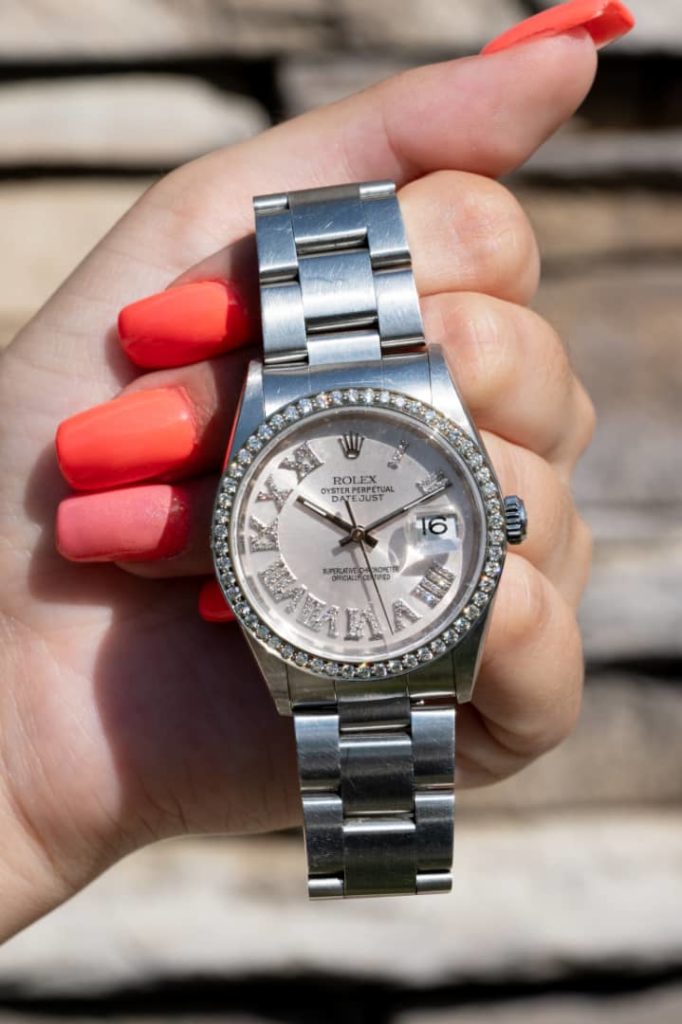
Do you wish to own a platinum Rolex timepiece? With the Rolesium, you get an inexpensive way to add one to your collection. Still, it retains all of the strength of a stainless steel Rolex and the additional luster.
-
Sterling Silver Material for Vintage Rolex Timepieces
This information might come as a shock to some. At some point in the history of this watchmaker, it produced sterling silver timepieces. These sterling silver Rolex watches pre-date the Oyster case (1926). Also, here you have vintage pieces that come in a bunch of various shaped cases.
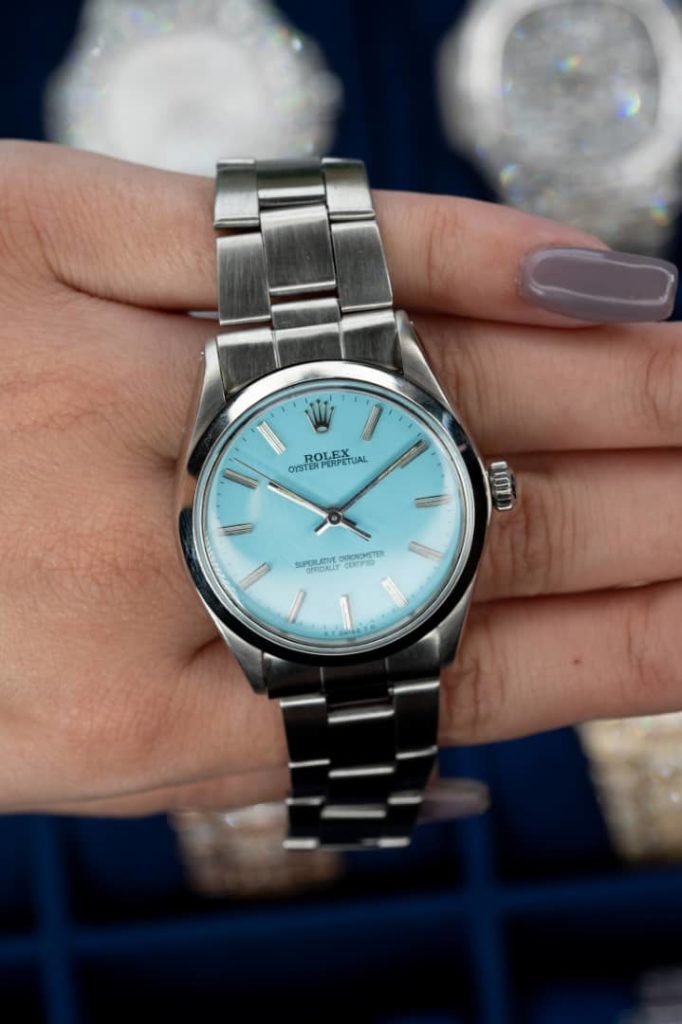
In times past, Rolex created square silver cases, rectangular silver cases, cushion-shaped silver cases, decorative ladies’ silver cases, and even silver trench officer’s cases. All of these complete with a hinged caseback that allows easy opening and closing.
Note that Rolex no longer produces sterling silver watches. More so, considering the metal’s tendency to get tarnished and its exposure to scratching, that is not a surprise.
Conclusion
These Rolex metal options open up a wide array of choices for every Rolex lover. Depending on your budget and preference, there is enough of these Rolex materials to go round.
Ten articles before and after
The Zenith Movement in the Rolex Daytona – Diamonds By Raymond Lee
Omega Speedmaster with Blue Dial – Diamonds By Raymond Lee
Omega Moonwatch Co-Axial Master Chronometer Moonphase Watch – Diamonds By Raymond Lee
Rectangular Solitaire with Half Eternity Band – Diamonds By Raymond Lee
Omega Seamaster Diver 300M – Diamonds By Raymond Lee
Rolex Daytona Zenith 18k 16528 – Diamonds By Raymond Lee
Audemars Piguet Royal Oak Skeleton 41mm Steel – Diamonds By Raymond Lee
Rolex Sea Dweller with Sapphires and Diamonds – Diamonds By Raymond Lee
Oval Cut Diamond Halo Ring – Diamonds By Raymond Lee
Blue Rolex Deepsea Sea-Dweller 43mm – Diamonds By Raymond Lee

